Analyzing the Development and Changes in Sydney's Transport System
VerifiedAdded on 2021/05/27
|9
|2808
|348
Report
AI Summary
This report delves into the historical evolution of Sydney's transport system, analyzing the development of roads, railways, and ferry services. It begins by highlighting the initial challenges and scarcity of resources, such as draught animals, which led to the use of human labor and the eventual development of various transport facilities. The report then explores the evolution of different modes of transport, including roads, buses, trams, and railways, detailing the impact of government policies, such as the Transport Act of 1930 and the State Transport (Coordination) Act, on the industry. It also examines the role of private companies and the restructuring of transport systems. The report further discusses the development of the railway system, from its early beginnings to the adoption of different gauges and the eventual standardization of the network. Finally, it covers the history of ferry services, their popularity, and the factors influencing their evolution. The report provides a comprehensive overview of the changes and developments in Sydney's transport infrastructure, offering insights into the city's historical and current transport landscape.

Business Law 1
Business Law
Business Law
Paraphrase This Document
Need a fresh take? Get an instant paraphrase of this document with our AI Paraphraser
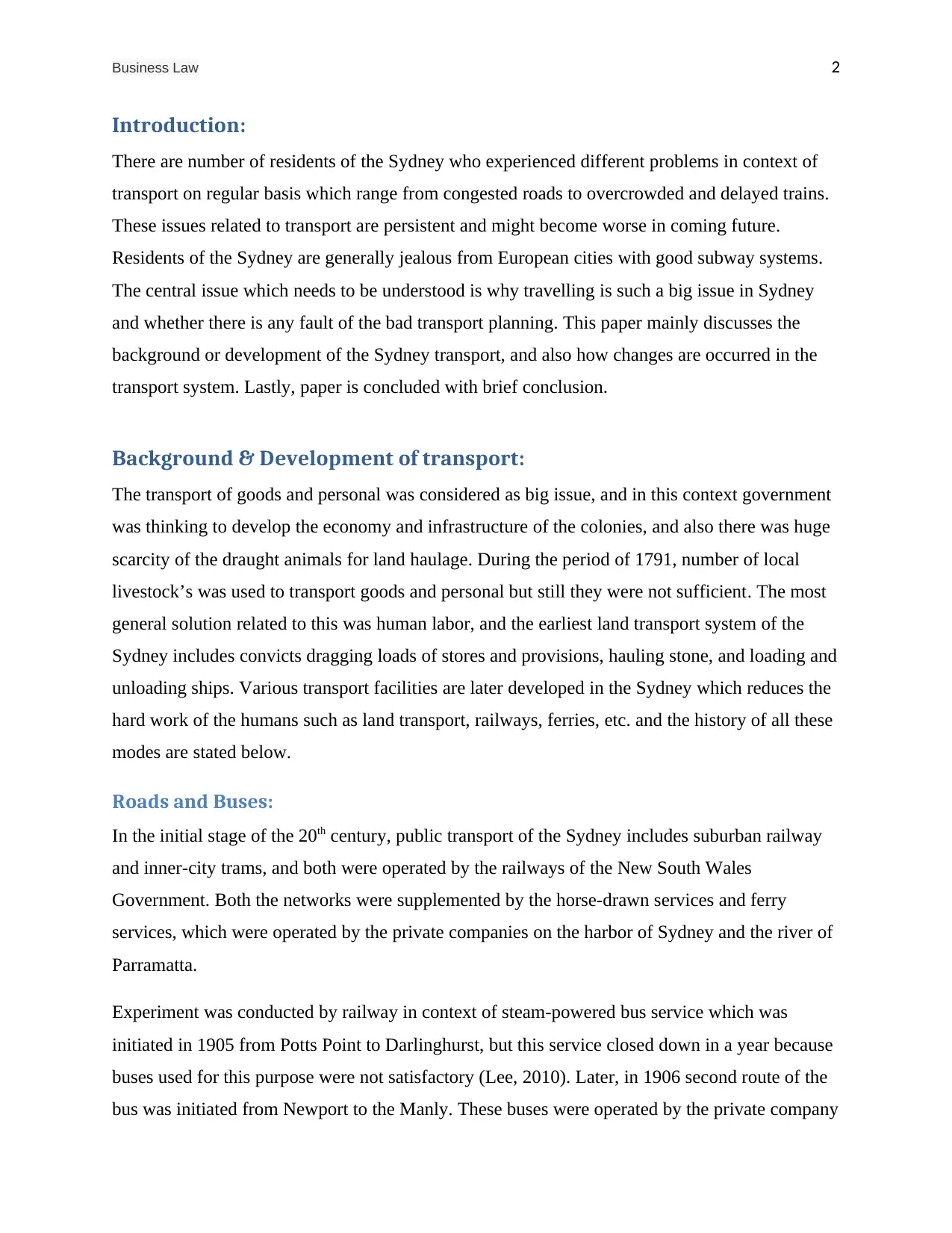
Business Law 2
Introduction:
There are number of residents of the Sydney who experienced different problems in context of
transport on regular basis which range from congested roads to overcrowded and delayed trains.
These issues related to transport are persistent and might become worse in coming future.
Residents of the Sydney are generally jealous from European cities with good subway systems.
The central issue which needs to be understood is why travelling is such a big issue in Sydney
and whether there is any fault of the bad transport planning. This paper mainly discusses the
background or development of the Sydney transport, and also how changes are occurred in the
transport system. Lastly, paper is concluded with brief conclusion.
Background & Development of transport:
The transport of goods and personal was considered as big issue, and in this context government
was thinking to develop the economy and infrastructure of the colonies, and also there was huge
scarcity of the draught animals for land haulage. During the period of 1791, number of local
livestock’s was used to transport goods and personal but still they were not sufficient. The most
general solution related to this was human labor, and the earliest land transport system of the
Sydney includes convicts dragging loads of stores and provisions, hauling stone, and loading and
unloading ships. Various transport facilities are later developed in the Sydney which reduces the
hard work of the humans such as land transport, railways, ferries, etc. and the history of all these
modes are stated below.
Roads and Buses:
In the initial stage of the 20th century, public transport of the Sydney includes suburban railway
and inner-city trams, and both were operated by the railways of the New South Wales
Government. Both the networks were supplemented by the horse-drawn services and ferry
services, which were operated by the private companies on the harbor of Sydney and the river of
Parramatta.
Experiment was conducted by railway in context of steam-powered bus service which was
initiated in 1905 from Potts Point to Darlinghurst, but this service closed down in a year because
buses used for this purpose were not satisfactory (Lee, 2010). Later, in 1906 second route of the
bus was initiated from Newport to the Manly. These buses were operated by the private company
Introduction:
There are number of residents of the Sydney who experienced different problems in context of
transport on regular basis which range from congested roads to overcrowded and delayed trains.
These issues related to transport are persistent and might become worse in coming future.
Residents of the Sydney are generally jealous from European cities with good subway systems.
The central issue which needs to be understood is why travelling is such a big issue in Sydney
and whether there is any fault of the bad transport planning. This paper mainly discusses the
background or development of the Sydney transport, and also how changes are occurred in the
transport system. Lastly, paper is concluded with brief conclusion.
Background & Development of transport:
The transport of goods and personal was considered as big issue, and in this context government
was thinking to develop the economy and infrastructure of the colonies, and also there was huge
scarcity of the draught animals for land haulage. During the period of 1791, number of local
livestock’s was used to transport goods and personal but still they were not sufficient. The most
general solution related to this was human labor, and the earliest land transport system of the
Sydney includes convicts dragging loads of stores and provisions, hauling stone, and loading and
unloading ships. Various transport facilities are later developed in the Sydney which reduces the
hard work of the humans such as land transport, railways, ferries, etc. and the history of all these
modes are stated below.
Roads and Buses:
In the initial stage of the 20th century, public transport of the Sydney includes suburban railway
and inner-city trams, and both were operated by the railways of the New South Wales
Government. Both the networks were supplemented by the horse-drawn services and ferry
services, which were operated by the private companies on the harbor of Sydney and the river of
Parramatta.
Experiment was conducted by railway in context of steam-powered bus service which was
initiated in 1905 from Potts Point to Darlinghurst, but this service closed down in a year because
buses used for this purpose were not satisfactory (Lee, 2010). Later, in 1906 second route of the
bus was initiated from Newport to the Manly. These buses were operated by the private company
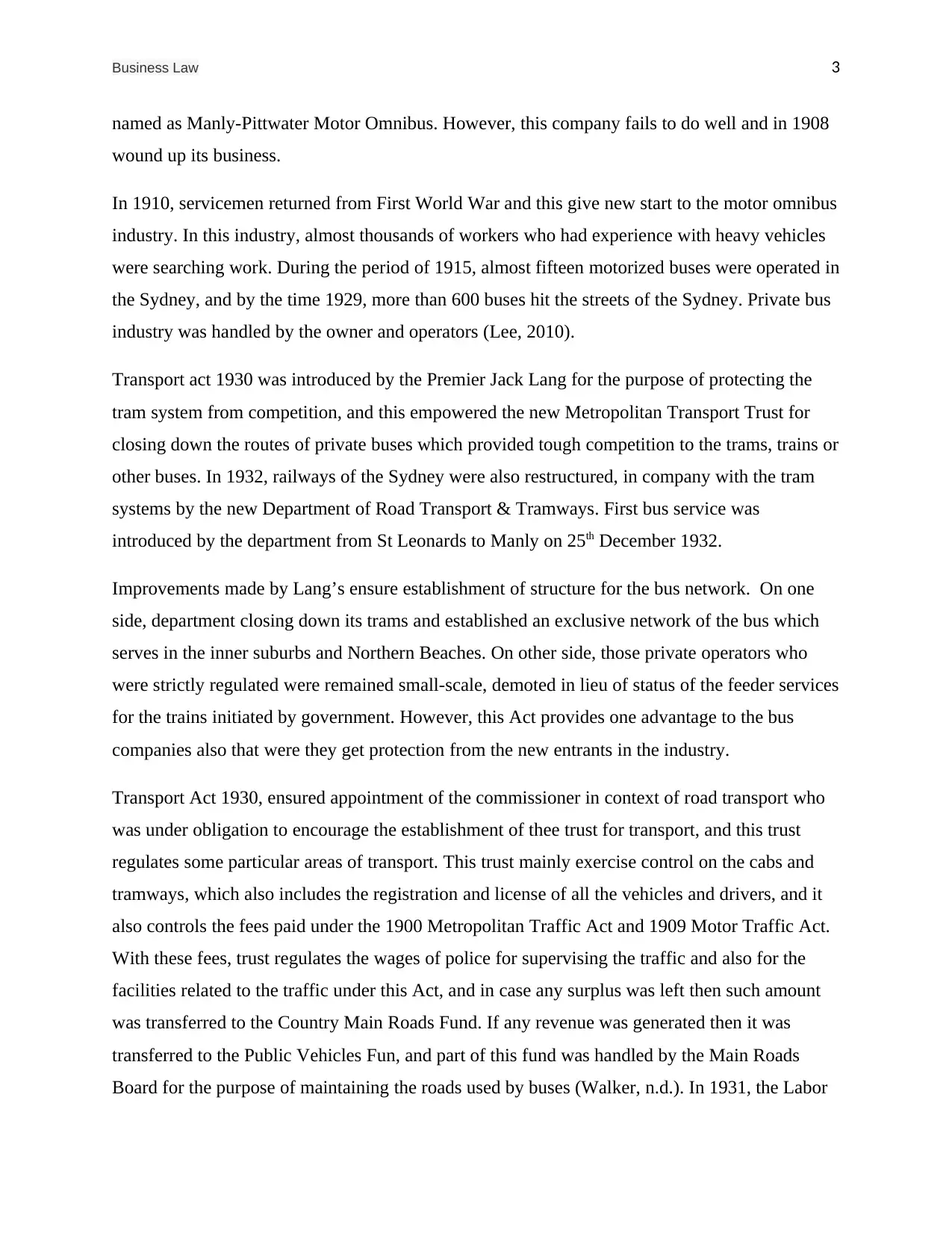
Business Law 3
named as Manly-Pittwater Motor Omnibus. However, this company fails to do well and in 1908
wound up its business.
In 1910, servicemen returned from First World War and this give new start to the motor omnibus
industry. In this industry, almost thousands of workers who had experience with heavy vehicles
were searching work. During the period of 1915, almost fifteen motorized buses were operated in
the Sydney, and by the time 1929, more than 600 buses hit the streets of the Sydney. Private bus
industry was handled by the owner and operators (Lee, 2010).
Transport act 1930 was introduced by the Premier Jack Lang for the purpose of protecting the
tram system from competition, and this empowered the new Metropolitan Transport Trust for
closing down the routes of private buses which provided tough competition to the trams, trains or
other buses. In 1932, railways of the Sydney were also restructured, in company with the tram
systems by the new Department of Road Transport & Tramways. First bus service was
introduced by the department from St Leonards to Manly on 25th December 1932.
Improvements made by Lang’s ensure establishment of structure for the bus network. On one
side, department closing down its trams and established an exclusive network of the bus which
serves in the inner suburbs and Northern Beaches. On other side, those private operators who
were strictly regulated were remained small-scale, demoted in lieu of status of the feeder services
for the trains initiated by government. However, this Act provides one advantage to the bus
companies also that were they get protection from the new entrants in the industry.
Transport Act 1930, ensured appointment of the commissioner in context of road transport who
was under obligation to encourage the establishment of thee trust for transport, and this trust
regulates some particular areas of transport. This trust mainly exercise control on the cabs and
tramways, which also includes the registration and license of all the vehicles and drivers, and it
also controls the fees paid under the 1900 Metropolitan Traffic Act and 1909 Motor Traffic Act.
With these fees, trust regulates the wages of police for supervising the traffic and also for the
facilities related to the traffic under this Act, and in case any surplus was left then such amount
was transferred to the Country Main Roads Fund. If any revenue was generated then it was
transferred to the Public Vehicles Fun, and part of this fund was handled by the Main Roads
Board for the purpose of maintaining the roads used by buses (Walker, n.d.). In 1931, the Labor
named as Manly-Pittwater Motor Omnibus. However, this company fails to do well and in 1908
wound up its business.
In 1910, servicemen returned from First World War and this give new start to the motor omnibus
industry. In this industry, almost thousands of workers who had experience with heavy vehicles
were searching work. During the period of 1915, almost fifteen motorized buses were operated in
the Sydney, and by the time 1929, more than 600 buses hit the streets of the Sydney. Private bus
industry was handled by the owner and operators (Lee, 2010).
Transport act 1930 was introduced by the Premier Jack Lang for the purpose of protecting the
tram system from competition, and this empowered the new Metropolitan Transport Trust for
closing down the routes of private buses which provided tough competition to the trams, trains or
other buses. In 1932, railways of the Sydney were also restructured, in company with the tram
systems by the new Department of Road Transport & Tramways. First bus service was
introduced by the department from St Leonards to Manly on 25th December 1932.
Improvements made by Lang’s ensure establishment of structure for the bus network. On one
side, department closing down its trams and established an exclusive network of the bus which
serves in the inner suburbs and Northern Beaches. On other side, those private operators who
were strictly regulated were remained small-scale, demoted in lieu of status of the feeder services
for the trains initiated by government. However, this Act provides one advantage to the bus
companies also that were they get protection from the new entrants in the industry.
Transport Act 1930, ensured appointment of the commissioner in context of road transport who
was under obligation to encourage the establishment of thee trust for transport, and this trust
regulates some particular areas of transport. This trust mainly exercise control on the cabs and
tramways, which also includes the registration and license of all the vehicles and drivers, and it
also controls the fees paid under the 1900 Metropolitan Traffic Act and 1909 Motor Traffic Act.
With these fees, trust regulates the wages of police for supervising the traffic and also for the
facilities related to the traffic under this Act, and in case any surplus was left then such amount
was transferred to the Country Main Roads Fund. If any revenue was generated then it was
transferred to the Public Vehicles Fun, and part of this fund was handled by the Main Roads
Board for the purpose of maintaining the roads used by buses (Walker, n.d.). In 1931, the Labor
⊘ This is a preview!⊘
Do you want full access?
Subscribe today to unlock all pages.

Trusted by 1+ million students worldwide
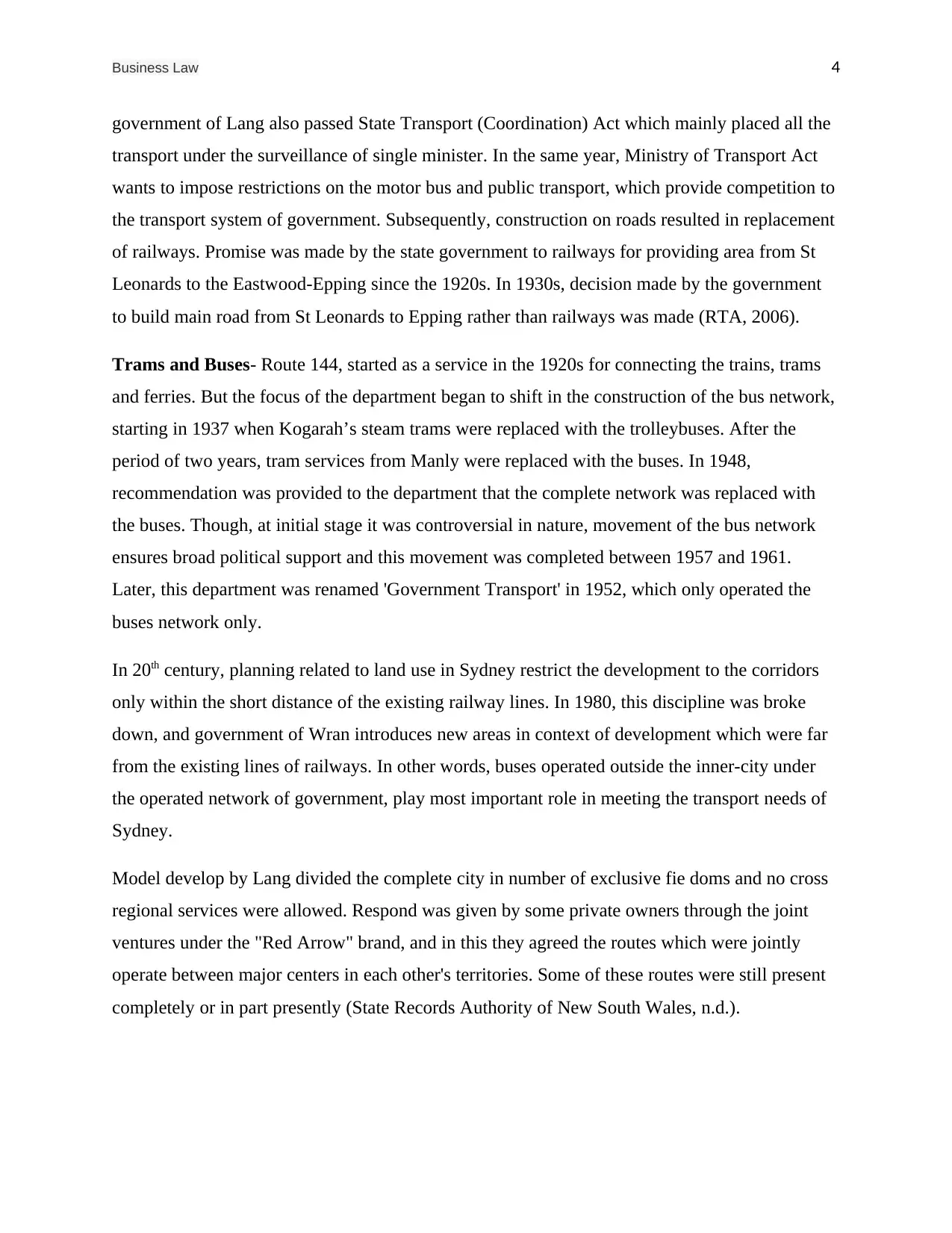
Business Law 4
government of Lang also passed State Transport (Coordination) Act which mainly placed all the
transport under the surveillance of single minister. In the same year, Ministry of Transport Act
wants to impose restrictions on the motor bus and public transport, which provide competition to
the transport system of government. Subsequently, construction on roads resulted in replacement
of railways. Promise was made by the state government to railways for providing area from St
Leonards to the Eastwood-Epping since the 1920s. In 1930s, decision made by the government
to build main road from St Leonards to Epping rather than railways was made (RTA, 2006).
Trams and Buses- Route 144, started as a service in the 1920s for connecting the trains, trams
and ferries. But the focus of the department began to shift in the construction of the bus network,
starting in 1937 when Kogarah’s steam trams were replaced with the trolleybuses. After the
period of two years, tram services from Manly were replaced with the buses. In 1948,
recommendation was provided to the department that the complete network was replaced with
the buses. Though, at initial stage it was controversial in nature, movement of the bus network
ensures broad political support and this movement was completed between 1957 and 1961.
Later, this department was renamed 'Government Transport' in 1952, which only operated the
buses network only.
In 20th century, planning related to land use in Sydney restrict the development to the corridors
only within the short distance of the existing railway lines. In 1980, this discipline was broke
down, and government of Wran introduces new areas in context of development which were far
from the existing lines of railways. In other words, buses operated outside the inner-city under
the operated network of government, play most important role in meeting the transport needs of
Sydney.
Model develop by Lang divided the complete city in number of exclusive fie doms and no cross
regional services were allowed. Respond was given by some private owners through the joint
ventures under the "Red Arrow" brand, and in this they agreed the routes which were jointly
operate between major centers in each other's territories. Some of these routes were still present
completely or in part presently (State Records Authority of New South Wales, n.d.).
government of Lang also passed State Transport (Coordination) Act which mainly placed all the
transport under the surveillance of single minister. In the same year, Ministry of Transport Act
wants to impose restrictions on the motor bus and public transport, which provide competition to
the transport system of government. Subsequently, construction on roads resulted in replacement
of railways. Promise was made by the state government to railways for providing area from St
Leonards to the Eastwood-Epping since the 1920s. In 1930s, decision made by the government
to build main road from St Leonards to Epping rather than railways was made (RTA, 2006).
Trams and Buses- Route 144, started as a service in the 1920s for connecting the trains, trams
and ferries. But the focus of the department began to shift in the construction of the bus network,
starting in 1937 when Kogarah’s steam trams were replaced with the trolleybuses. After the
period of two years, tram services from Manly were replaced with the buses. In 1948,
recommendation was provided to the department that the complete network was replaced with
the buses. Though, at initial stage it was controversial in nature, movement of the bus network
ensures broad political support and this movement was completed between 1957 and 1961.
Later, this department was renamed 'Government Transport' in 1952, which only operated the
buses network only.
In 20th century, planning related to land use in Sydney restrict the development to the corridors
only within the short distance of the existing railway lines. In 1980, this discipline was broke
down, and government of Wran introduces new areas in context of development which were far
from the existing lines of railways. In other words, buses operated outside the inner-city under
the operated network of government, play most important role in meeting the transport needs of
Sydney.
Model develop by Lang divided the complete city in number of exclusive fie doms and no cross
regional services were allowed. Respond was given by some private owners through the joint
ventures under the "Red Arrow" brand, and in this they agreed the routes which were jointly
operate between major centers in each other's territories. Some of these routes were still present
completely or in part presently (State Records Authority of New South Wales, n.d.).
Paraphrase This Document
Need a fresh take? Get an instant paraphrase of this document with our AI Paraphraser
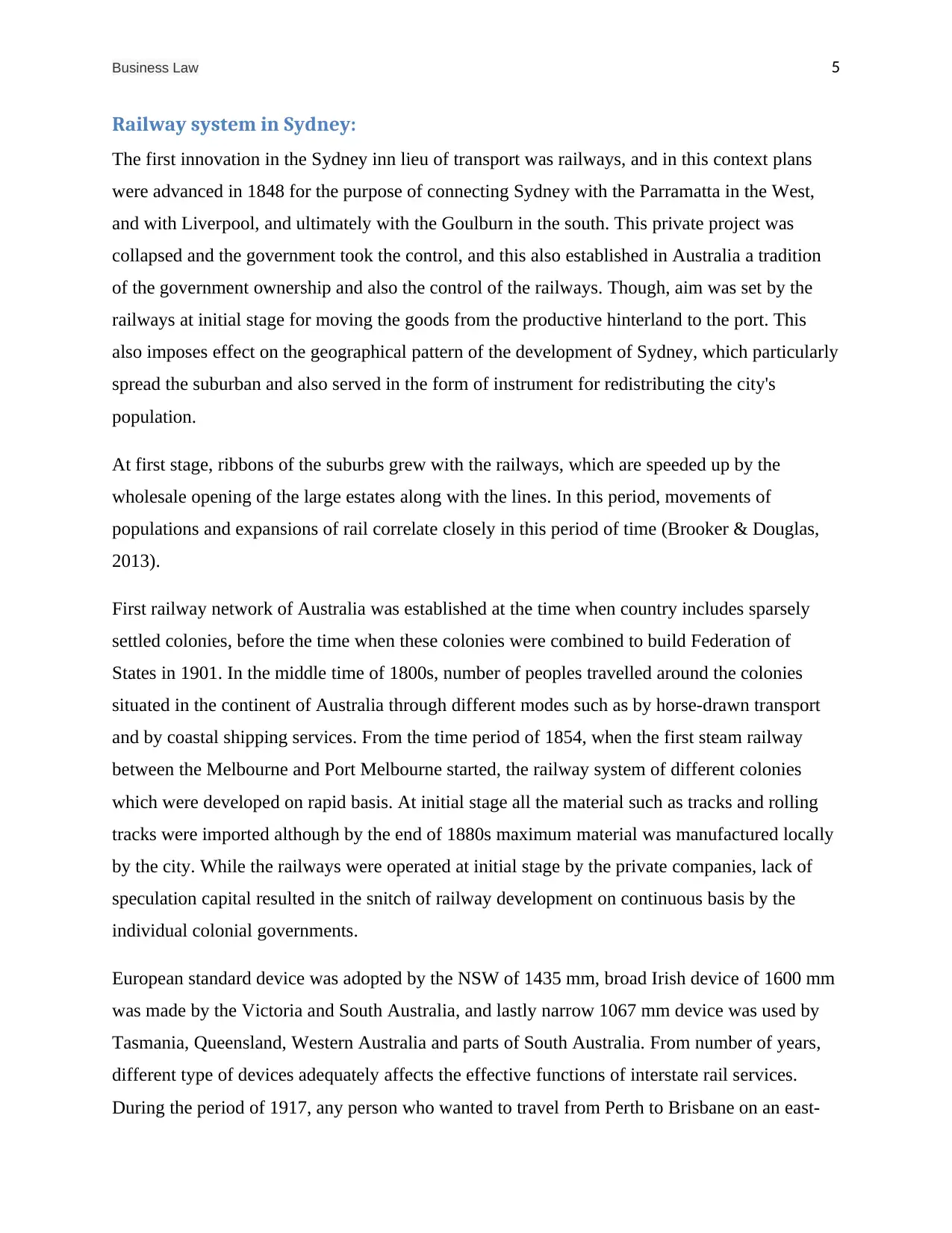
Business Law 5
Railway system in Sydney:
The first innovation in the Sydney inn lieu of transport was railways, and in this context plans
were advanced in 1848 for the purpose of connecting Sydney with the Parramatta in the West,
and with Liverpool, and ultimately with the Goulburn in the south. This private project was
collapsed and the government took the control, and this also established in Australia a tradition
of the government ownership and also the control of the railways. Though, aim was set by the
railways at initial stage for moving the goods from the productive hinterland to the port. This
also imposes effect on the geographical pattern of the development of Sydney, which particularly
spread the suburban and also served in the form of instrument for redistributing the city's
population.
At first stage, ribbons of the suburbs grew with the railways, which are speeded up by the
wholesale opening of the large estates along with the lines. In this period, movements of
populations and expansions of rail correlate closely in this period of time (Brooker & Douglas,
2013).
First railway network of Australia was established at the time when country includes sparsely
settled colonies, before the time when these colonies were combined to build Federation of
States in 1901. In the middle time of 1800s, number of peoples travelled around the colonies
situated in the continent of Australia through different modes such as by horse-drawn transport
and by coastal shipping services. From the time period of 1854, when the first steam railway
between the Melbourne and Port Melbourne started, the railway system of different colonies
which were developed on rapid basis. At initial stage all the material such as tracks and rolling
tracks were imported although by the end of 1880s maximum material was manufactured locally
by the city. While the railways were operated at initial stage by the private companies, lack of
speculation capital resulted in the snitch of railway development on continuous basis by the
individual colonial governments.
European standard device was adopted by the NSW of 1435 mm, broad Irish device of 1600 mm
was made by the Victoria and South Australia, and lastly narrow 1067 mm device was used by
Tasmania, Queensland, Western Australia and parts of South Australia. From number of years,
different type of devices adequately affects the effective functions of interstate rail services.
During the period of 1917, any person who wanted to travel from Perth to Brisbane on an east-
Railway system in Sydney:
The first innovation in the Sydney inn lieu of transport was railways, and in this context plans
were advanced in 1848 for the purpose of connecting Sydney with the Parramatta in the West,
and with Liverpool, and ultimately with the Goulburn in the south. This private project was
collapsed and the government took the control, and this also established in Australia a tradition
of the government ownership and also the control of the railways. Though, aim was set by the
railways at initial stage for moving the goods from the productive hinterland to the port. This
also imposes effect on the geographical pattern of the development of Sydney, which particularly
spread the suburban and also served in the form of instrument for redistributing the city's
population.
At first stage, ribbons of the suburbs grew with the railways, which are speeded up by the
wholesale opening of the large estates along with the lines. In this period, movements of
populations and expansions of rail correlate closely in this period of time (Brooker & Douglas,
2013).
First railway network of Australia was established at the time when country includes sparsely
settled colonies, before the time when these colonies were combined to build Federation of
States in 1901. In the middle time of 1800s, number of peoples travelled around the colonies
situated in the continent of Australia through different modes such as by horse-drawn transport
and by coastal shipping services. From the time period of 1854, when the first steam railway
between the Melbourne and Port Melbourne started, the railway system of different colonies
which were developed on rapid basis. At initial stage all the material such as tracks and rolling
tracks were imported although by the end of 1880s maximum material was manufactured locally
by the city. While the railways were operated at initial stage by the private companies, lack of
speculation capital resulted in the snitch of railway development on continuous basis by the
individual colonial governments.
European standard device was adopted by the NSW of 1435 mm, broad Irish device of 1600 mm
was made by the Victoria and South Australia, and lastly narrow 1067 mm device was used by
Tasmania, Queensland, Western Australia and parts of South Australia. From number of years,
different type of devices adequately affects the effective functions of interstate rail services.
During the period of 1917, any person who wanted to travel from Perth to Brisbane on an east-
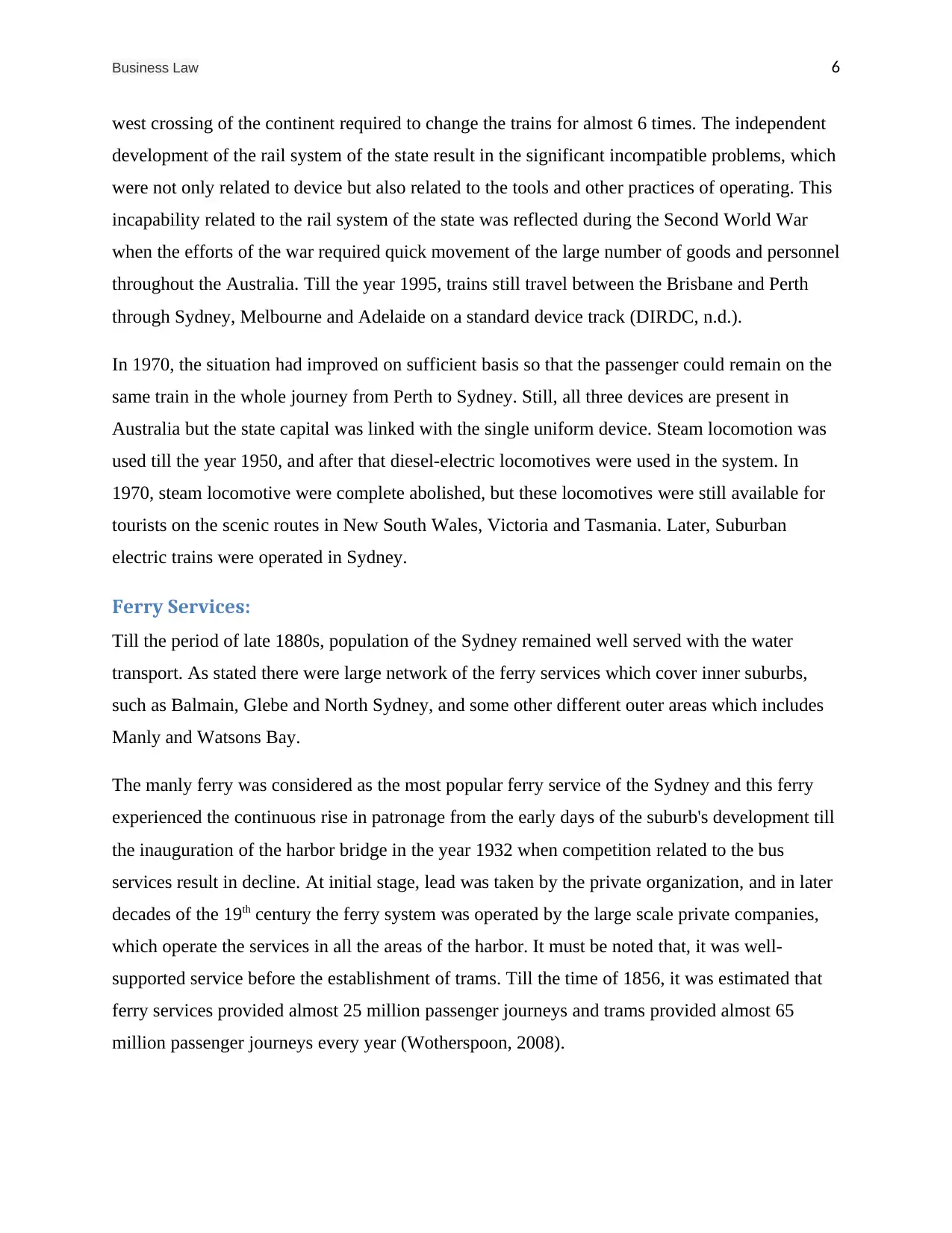
Business Law 6
west crossing of the continent required to change the trains for almost 6 times. The independent
development of the rail system of the state result in the significant incompatible problems, which
were not only related to device but also related to the tools and other practices of operating. This
incapability related to the rail system of the state was reflected during the Second World War
when the efforts of the war required quick movement of the large number of goods and personnel
throughout the Australia. Till the year 1995, trains still travel between the Brisbane and Perth
through Sydney, Melbourne and Adelaide on a standard device track (DIRDC, n.d.).
In 1970, the situation had improved on sufficient basis so that the passenger could remain on the
same train in the whole journey from Perth to Sydney. Still, all three devices are present in
Australia but the state capital was linked with the single uniform device. Steam locomotion was
used till the year 1950, and after that diesel-electric locomotives were used in the system. In
1970, steam locomotive were complete abolished, but these locomotives were still available for
tourists on the scenic routes in New South Wales, Victoria and Tasmania. Later, Suburban
electric trains were operated in Sydney.
Ferry Services:
Till the period of late 1880s, population of the Sydney remained well served with the water
transport. As stated there were large network of the ferry services which cover inner suburbs,
such as Balmain, Glebe and North Sydney, and some other different outer areas which includes
Manly and Watsons Bay.
The manly ferry was considered as the most popular ferry service of the Sydney and this ferry
experienced the continuous rise in patronage from the early days of the suburb's development till
the inauguration of the harbor bridge in the year 1932 when competition related to the bus
services result in decline. At initial stage, lead was taken by the private organization, and in later
decades of the 19th century the ferry system was operated by the large scale private companies,
which operate the services in all the areas of the harbor. It must be noted that, it was well-
supported service before the establishment of trams. Till the time of 1856, it was estimated that
ferry services provided almost 25 million passenger journeys and trams provided almost 65
million passenger journeys every year (Wotherspoon, 2008).
west crossing of the continent required to change the trains for almost 6 times. The independent
development of the rail system of the state result in the significant incompatible problems, which
were not only related to device but also related to the tools and other practices of operating. This
incapability related to the rail system of the state was reflected during the Second World War
when the efforts of the war required quick movement of the large number of goods and personnel
throughout the Australia. Till the year 1995, trains still travel between the Brisbane and Perth
through Sydney, Melbourne and Adelaide on a standard device track (DIRDC, n.d.).
In 1970, the situation had improved on sufficient basis so that the passenger could remain on the
same train in the whole journey from Perth to Sydney. Still, all three devices are present in
Australia but the state capital was linked with the single uniform device. Steam locomotion was
used till the year 1950, and after that diesel-electric locomotives were used in the system. In
1970, steam locomotive were complete abolished, but these locomotives were still available for
tourists on the scenic routes in New South Wales, Victoria and Tasmania. Later, Suburban
electric trains were operated in Sydney.
Ferry Services:
Till the period of late 1880s, population of the Sydney remained well served with the water
transport. As stated there were large network of the ferry services which cover inner suburbs,
such as Balmain, Glebe and North Sydney, and some other different outer areas which includes
Manly and Watsons Bay.
The manly ferry was considered as the most popular ferry service of the Sydney and this ferry
experienced the continuous rise in patronage from the early days of the suburb's development till
the inauguration of the harbor bridge in the year 1932 when competition related to the bus
services result in decline. At initial stage, lead was taken by the private organization, and in later
decades of the 19th century the ferry system was operated by the large scale private companies,
which operate the services in all the areas of the harbor. It must be noted that, it was well-
supported service before the establishment of trams. Till the time of 1856, it was estimated that
ferry services provided almost 25 million passenger journeys and trams provided almost 65
million passenger journeys every year (Wotherspoon, 2008).
⊘ This is a preview!⊘
Do you want full access?
Subscribe today to unlock all pages.

Trusted by 1+ million students worldwide
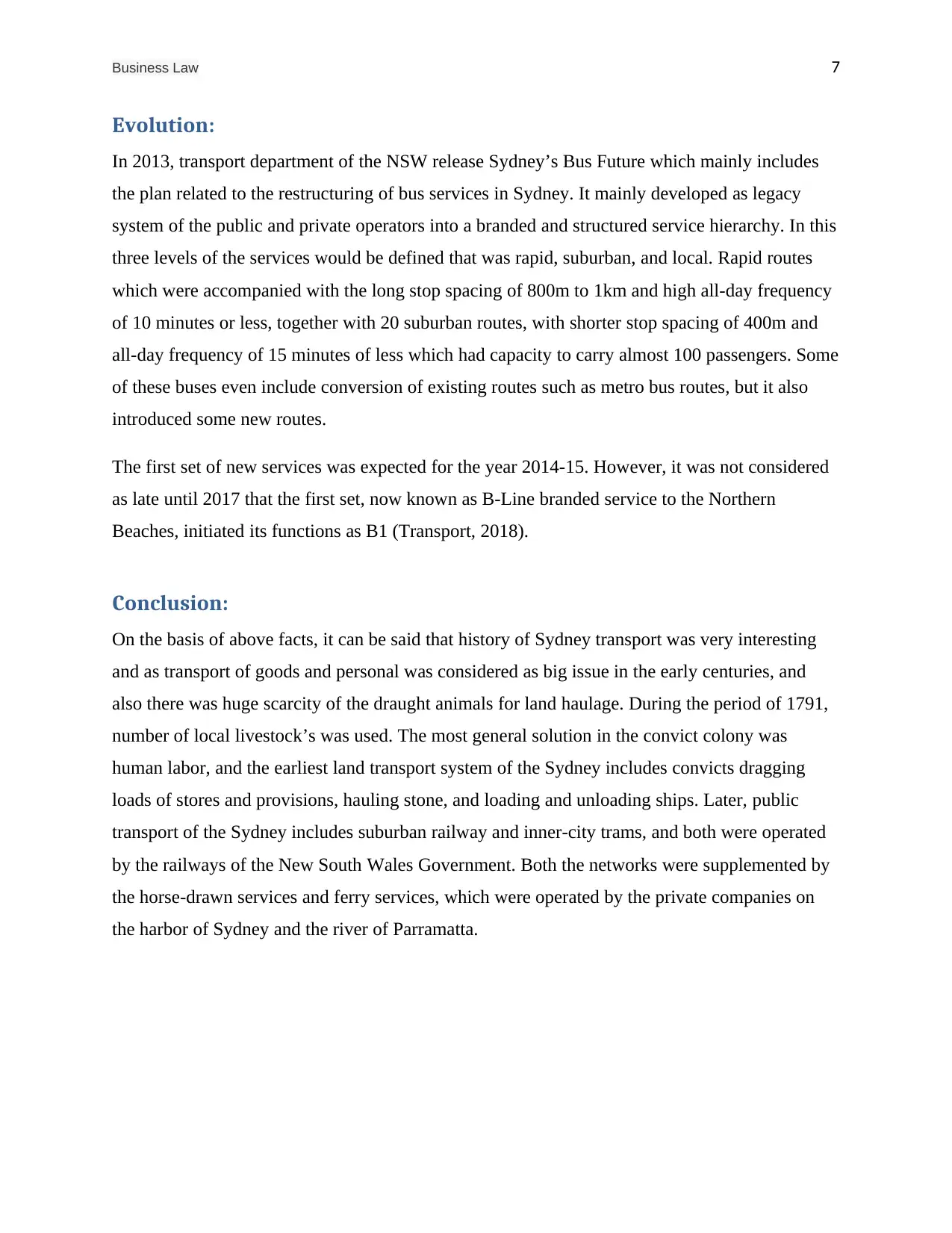
Business Law 7
Evolution:
In 2013, transport department of the NSW release Sydney’s Bus Future which mainly includes
the plan related to the restructuring of bus services in Sydney. It mainly developed as legacy
system of the public and private operators into a branded and structured service hierarchy. In this
three levels of the services would be defined that was rapid, suburban, and local. Rapid routes
which were accompanied with the long stop spacing of 800m to 1km and high all-day frequency
of 10 minutes or less, together with 20 suburban routes, with shorter stop spacing of 400m and
all-day frequency of 15 minutes of less which had capacity to carry almost 100 passengers. Some
of these buses even include conversion of existing routes such as metro bus routes, but it also
introduced some new routes.
The first set of new services was expected for the year 2014-15. However, it was not considered
as late until 2017 that the first set, now known as B-Line branded service to the Northern
Beaches, initiated its functions as B1 (Transport, 2018).
Conclusion:
On the basis of above facts, it can be said that history of Sydney transport was very interesting
and as transport of goods and personal was considered as big issue in the early centuries, and
also there was huge scarcity of the draught animals for land haulage. During the period of 1791,
number of local livestock’s was used. The most general solution in the convict colony was
human labor, and the earliest land transport system of the Sydney includes convicts dragging
loads of stores and provisions, hauling stone, and loading and unloading ships. Later, public
transport of the Sydney includes suburban railway and inner-city trams, and both were operated
by the railways of the New South Wales Government. Both the networks were supplemented by
the horse-drawn services and ferry services, which were operated by the private companies on
the harbor of Sydney and the river of Parramatta.
Evolution:
In 2013, transport department of the NSW release Sydney’s Bus Future which mainly includes
the plan related to the restructuring of bus services in Sydney. It mainly developed as legacy
system of the public and private operators into a branded and structured service hierarchy. In this
three levels of the services would be defined that was rapid, suburban, and local. Rapid routes
which were accompanied with the long stop spacing of 800m to 1km and high all-day frequency
of 10 minutes or less, together with 20 suburban routes, with shorter stop spacing of 400m and
all-day frequency of 15 minutes of less which had capacity to carry almost 100 passengers. Some
of these buses even include conversion of existing routes such as metro bus routes, but it also
introduced some new routes.
The first set of new services was expected for the year 2014-15. However, it was not considered
as late until 2017 that the first set, now known as B-Line branded service to the Northern
Beaches, initiated its functions as B1 (Transport, 2018).
Conclusion:
On the basis of above facts, it can be said that history of Sydney transport was very interesting
and as transport of goods and personal was considered as big issue in the early centuries, and
also there was huge scarcity of the draught animals for land haulage. During the period of 1791,
number of local livestock’s was used. The most general solution in the convict colony was
human labor, and the earliest land transport system of the Sydney includes convicts dragging
loads of stores and provisions, hauling stone, and loading and unloading ships. Later, public
transport of the Sydney includes suburban railway and inner-city trams, and both were operated
by the railways of the New South Wales Government. Both the networks were supplemented by
the horse-drawn services and ferry services, which were operated by the private companies on
the harbor of Sydney and the river of Parramatta.
Paraphrase This Document
Need a fresh take? Get an instant paraphrase of this document with our AI Paraphraser
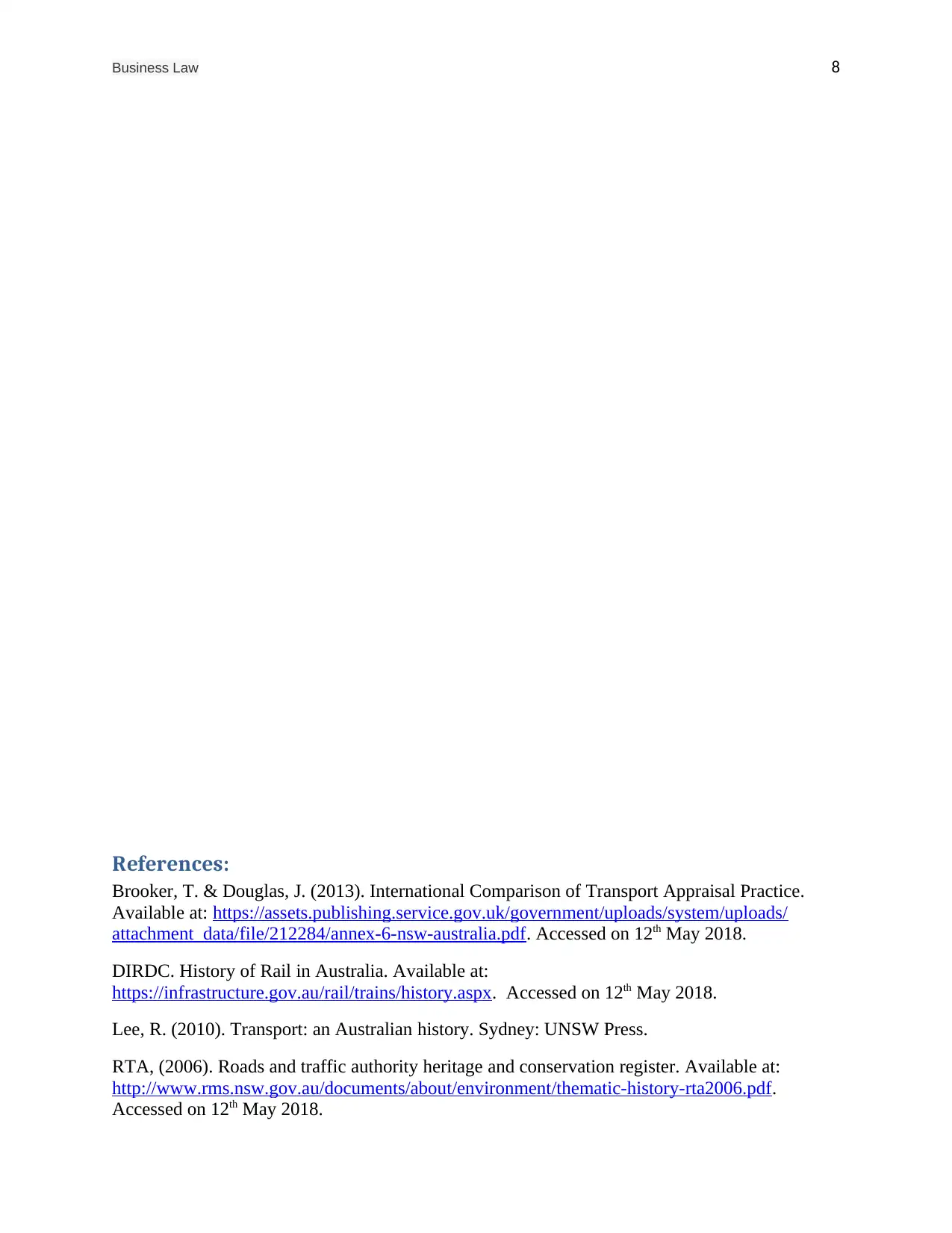
Business Law 8
References:
Brooker, T. & Douglas, J. (2013). International Comparison of Transport Appraisal Practice.
Available at: https://assets.publishing.service.gov.uk/government/uploads/system/uploads/
attachment_data/file/212284/annex-6-nsw-australia.pdf. Accessed on 12th May 2018.
DIRDC. History of Rail in Australia. Available at:
https://infrastructure.gov.au/rail/trains/history.aspx. Accessed on 12th May 2018.
Lee, R. (2010). Transport: an Australian history. Sydney: UNSW Press.
RTA, (2006). Roads and traffic authority heritage and conservation register. Available at:
http://www.rms.nsw.gov.au/documents/about/environment/thematic-history-rta2006.pdf.
Accessed on 12th May 2018.
References:
Brooker, T. & Douglas, J. (2013). International Comparison of Transport Appraisal Practice.
Available at: https://assets.publishing.service.gov.uk/government/uploads/system/uploads/
attachment_data/file/212284/annex-6-nsw-australia.pdf. Accessed on 12th May 2018.
DIRDC. History of Rail in Australia. Available at:
https://infrastructure.gov.au/rail/trains/history.aspx. Accessed on 12th May 2018.
Lee, R. (2010). Transport: an Australian history. Sydney: UNSW Press.
RTA, (2006). Roads and traffic authority heritage and conservation register. Available at:
http://www.rms.nsw.gov.au/documents/about/environment/thematic-history-rta2006.pdf.
Accessed on 12th May 2018.
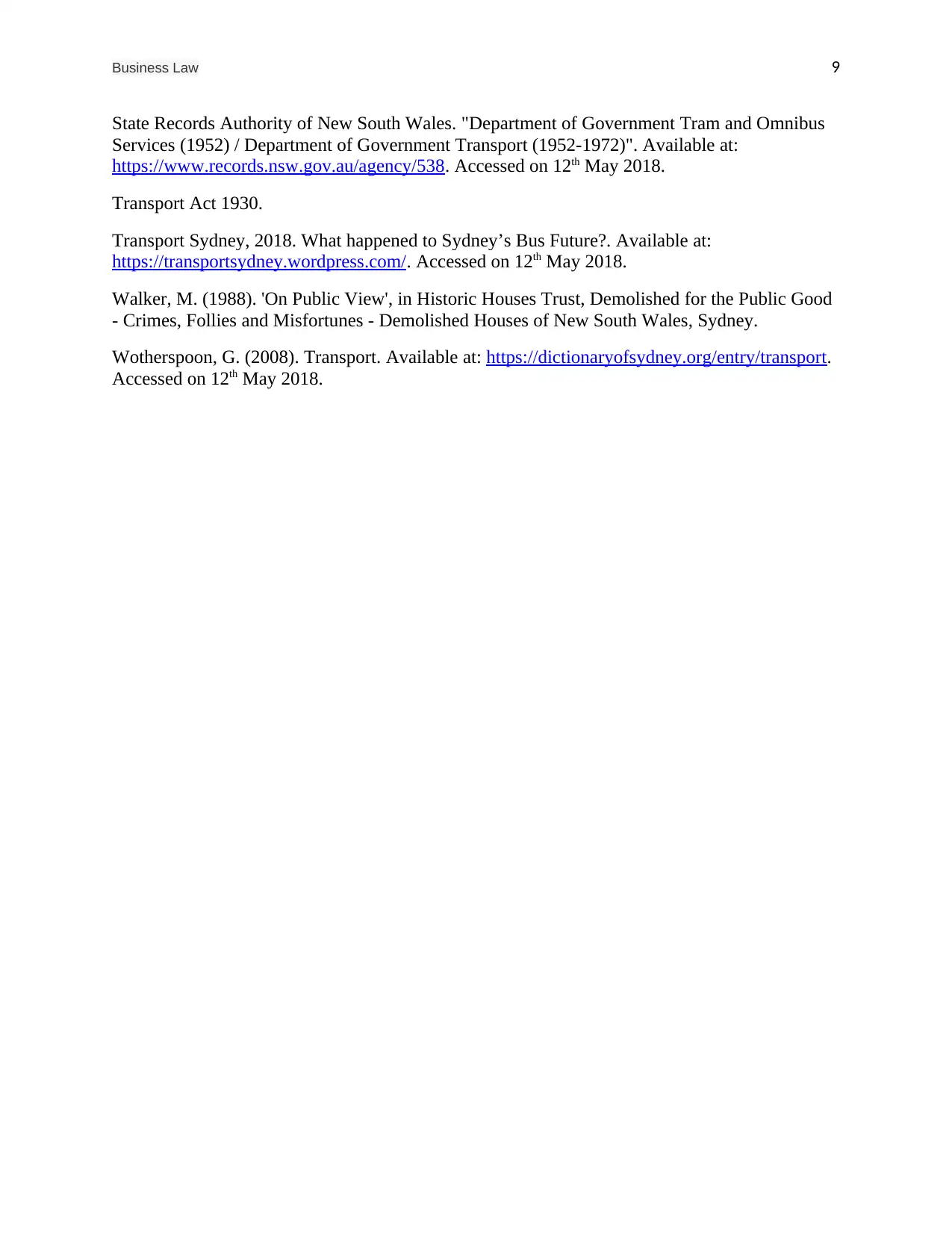
Business Law 9
State Records Authority of New South Wales. "Department of Government Tram and Omnibus
Services (1952) / Department of Government Transport (1952-1972)". Available at:
https://www.records.nsw.gov.au/agency/538. Accessed on 12th May 2018.
Transport Act 1930.
Transport Sydney, 2018. What happened to Sydney’s Bus Future?. Available at:
https://transportsydney.wordpress.com/. Accessed on 12th May 2018.
Walker, M. (1988). 'On Public View', in Historic Houses Trust, Demolished for the Public Good
- Crimes, Follies and Misfortunes - Demolished Houses of New South Wales, Sydney.
Wotherspoon, G. (2008). Transport. Available at: https://dictionaryofsydney.org/entry/transport.
Accessed on 12th May 2018.
State Records Authority of New South Wales. "Department of Government Tram and Omnibus
Services (1952) / Department of Government Transport (1952-1972)". Available at:
https://www.records.nsw.gov.au/agency/538. Accessed on 12th May 2018.
Transport Act 1930.
Transport Sydney, 2018. What happened to Sydney’s Bus Future?. Available at:
https://transportsydney.wordpress.com/. Accessed on 12th May 2018.
Walker, M. (1988). 'On Public View', in Historic Houses Trust, Demolished for the Public Good
- Crimes, Follies and Misfortunes - Demolished Houses of New South Wales, Sydney.
Wotherspoon, G. (2008). Transport. Available at: https://dictionaryofsydney.org/entry/transport.
Accessed on 12th May 2018.
⊘ This is a preview!⊘
Do you want full access?
Subscribe today to unlock all pages.

Trusted by 1+ million students worldwide
1 out of 9
Your All-in-One AI-Powered Toolkit for Academic Success.
+13062052269
info@desklib.com
Available 24*7 on WhatsApp / Email
![[object Object]](/_next/static/media/star-bottom.7253800d.svg)
Unlock your academic potential
Copyright © 2020–2025 A2Z Services. All Rights Reserved. Developed and managed by ZUCOL.

